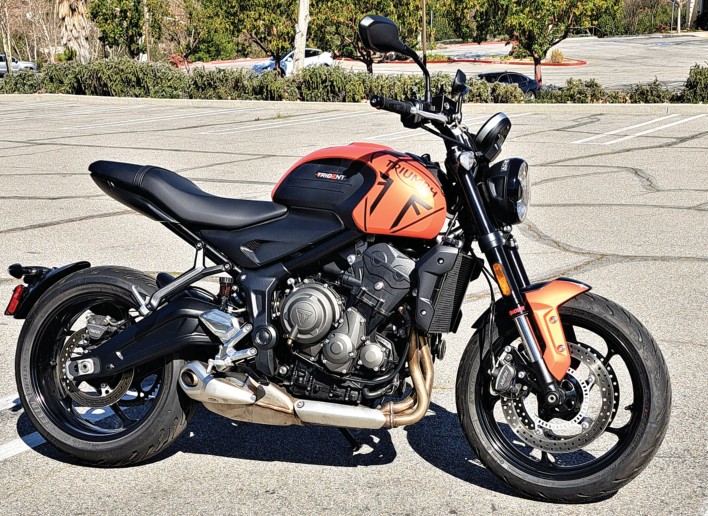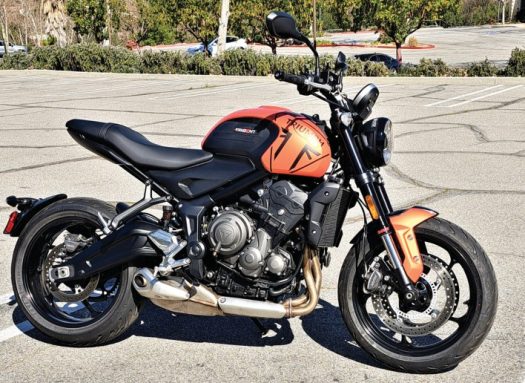
“Did you see me keeping pace with all those sportbikes back there?” he asks eagerly. The Trident has that effect on people as it fulfills its understated role as Triumph’s true sleeper in a vast lineup. There are far faster Triumphs and yes, there are models that wax the Trident’s unassuming style in the look-at-me department. But for a budget-priced middleweight, the Trident has the ability to make riding a genuine joy. “It’s very comfortable with a good seat that’s padded well, and the clutch is nice and buttery and it handles good and stops good,” were among Jay’s praises. “It’s a six speed, but for some weird reason it feels like it needs another gear at high speed. I’d use a bike like this for commuting, mostly, and you’re not really going to do much riding above say, 80 miles an hour, but it gets a little out of breath at the top end.”
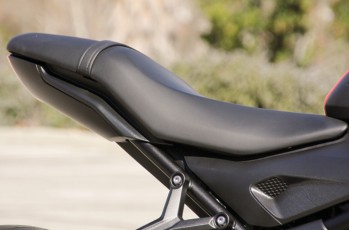
Jay found the Trident’s non-adjustable 41mm Showa forks capable and smooth, even after encountering a few pavement bumps. We didn’t dial in much extra preload for the rear shock, but Jay’s on the lighter side of our test crew, weighing less than 200 pounds even with a belly full of burritos and beer. “In the twisties, when I was throwing it around a bit, the bike never felt like you were taxing the suspension or tires more than they can handle,” he observed. “Comfort-wise it’s an A+. I like the riding position because I’m through with bikes with clip-ons that make you hunch over to ride them. This is the way to go unless you’re 23 years old or a yoga master,” he said.
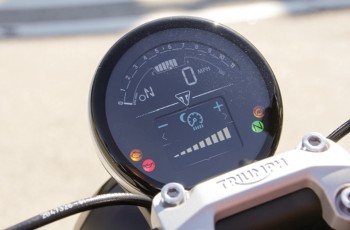
As a club racer who campaigns an MV Agusta, Jay found the Trident’s everyman’s approach to motorcycling a real pleasure. “There’s so much hype about these big, crazy 180-horsepower race replicas these days that everybody forgets – at least some of the guys I know that ride – that you can have just as much fun on a bike like the Trident that has average power and average speed. You always ride better when your In the unprecedented arms race to make motorcycles ever-more technologically complex for the generation raised with Play Station controllers permanently glued to their palms, it’s easy to forget how less can sometimes be more. Not that the Trident is a basic motorcycle. Not by any microprocessor it isn’t. The triple is equipped with a stiff, steel perimeter frame, 41mm Showa inverted forks, cast aluminum wheels, two separate riding modes, switchable traction control and anti-lock brakes (which are required by law these days). The 12-valve water-cooled motor is connected to the right twistgrip via ride-by-wire throttle and smoothly pulses out 81 crank horses at 10,250 revs. There’s 47 foot-pounds of torque on tap at a very accessible 6,500 RPM which means the Trident happily sails along in third or fourth gear like nobody’s business.
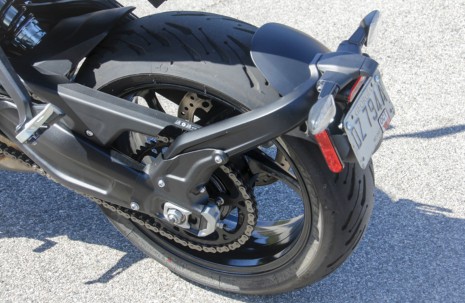
Practical yes, but how does it measure up among its peers? When parked up among the rows of tall-barred Harleys at Neptune’s Net, the popular rider’s roost on the Pacific Coast Highway, even the Sons of Anarchy wannabees in identical flannels and Vans smiled at the Trident’s curvaceous, compact lines. Riders old enough to remember kickstarters also had nice comments, with one in particular acknowledging how far better-looking this version is than the early 1990s Trident. They dug the stubby canister muffler that emits a mild-mannered whirr that was barely audible among the un muffled masses, but adding an aftermarket pipe with some three-cylinder growl would really help the Triumph make its mark.
So where, in between Triumph’s retro Modern Classics and sporty supernakeds does the Trident fit in? Quite nicely, we’d say. The bike has some sporting capabilities in its DNA and it’s nimble and maneuverable (not to mention light) enough to make a great first big bike for someone graduating from, say, a 300cc machine. The riding position is comfortable enough that all you’d need is a backpack for a 500-mile weekend jaunt and for those whose aching joints (that would be half our staff) preclude hopping aboard racier mounts, the Trident is that rare modern bike that’s kind to aging knees and backs. Not that we’d know. body is comfortable and you aren’t riding some crazy, track-based beast of a motorcycle that makes you feel like you wasted your money if you’re not riding at 100+ all the time. This is a full-on modern Triumph, but it really does take things back to the basics a little bit where you just have enough engine, good handling and good brakes so you can focus on fun,” he said.
2023 Triumph Trident 660cc
MSRP: $8,595
Engine: 12-valve, water-cooled in-line triple
Transmission: Six-speed
Brakes: Twin two-piston Nissin front calipers with 310mm rotors; single Nissin caliper rear with 255mm rotor
Wheels: Cast aluminum five-spoke 17×3.5” front; 17×5.5” rear
Tires: Michelin Road radials
Suspension: 41mm inverted Showa forks, non-adjustable with 4.7” travel: Showa monoshock preload adjustable
Power: 81 horsepower @10,250 RPM; 47 foot-pounds torque at 6,500 RPM
Fuel Capacity/Economy: 3.7 US gallons/50 MPG average
Electronics: Two riding modes (rain and road) ABS
Service Intervals: 10,000 miles
We Dig: The ease of use, smooth power, smooth shifting and featherweight handling
We’d Ditch: Besides the too-quiet muffler, the Trident 660 is spot-on
